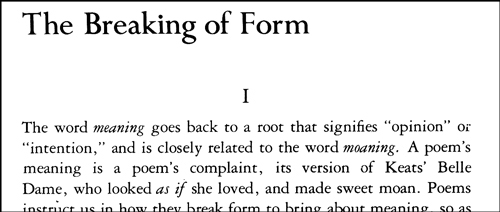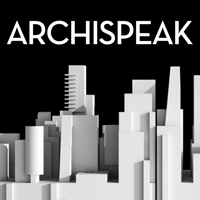The Breaking of Form
I think there is a turning point for most college students when the clouds part and they fully start to realize how much their education has transformed their way of thinking.
For me, my moment came when I started seeing common threads between different disciplines. Normally, one would think architecture has very little to do with poetry, or that philosophy has nothing in common with mathematics. It was when the barriers between these dropped for me that my learning became really fun.
I was in architecture school through the mid ’90s when deconstruction was the trendy rebel philosophy, and we were all tearing apart our designs, disassembling, analyzing, and reassembling the abstractions. Amidst this, I did a lot of reading, delving into the writings of icons like Kipnis and Derrida to inspire my thought processes. One text I came across was a small manifesto compilation entitled Deconstruction & Criticism. Compiled as a literary criticism, the “hermeneutical Mafia” authors had intended this as a pointed argument for the priority of language over meaning.
The very first essay “The Breaking of Form” by Harold Bloom, addresses this very openly, and speaks in so general a language at points, I thought it interesting that one could almost universally substitute ‘architecture’ where he wrote ‘poetry’ and ‘design’ where’ he wrote ‘language’ an the whole would still make perfect, and often fascinatingly insightful sense. So, to indulge my collegiate musing over a decade on, I’m going to reiterate a portion of the text here with just such modifications noted in grey:
____________________________________________
The Breaking of Form
The word meaning goes back to a root that signifies “opinion” or “intention,” and is closely related to the word moaning. An architectural meaning is an architectural complaint, its version of Keats’ Belle Dame, who looked as if she loved, and made sweet moan. Architectural designs instruct us in how they break form to bring about meaning, so as to utter a complaint, a moaning intended to be all their own . The word form goes back to a root meaning “to gleam” or “to sparkle,” but in architecture it is not form itself that gleams or sparkles. I will try to show that the lustres of architectural meaning come rather from the breaking apart of form, from the shattering of a visionary gleam.
What is called “form” in architecture is itself a trope, a figurative substitution of the as-it-were “outside” of a design for what the architecture is supposed to represent or be “about.” Etymologically, “about” means “to be on the outside of” something anyway, and so “about” in regard to architecture is in itself only another trope. Is there some way out the this wilderness of tropes, so that we can recover some sense of either a visitor’s or designer’s other-than-visual needs and desires?
All that an architecture can be about, or what in a design is other than trope, is the skill or faculty of invention or discovery, the heuristic gift. Invention is a matter of “places,” of themes, topics, subjects, or of what Kenneth Burke rephrased as the implicit presence of forms in subject matter, and named as “the Individuation of Forms.” Burke defined form in architecture as “an arousing and fulfillment of desires.” The Burkean formula offered in his early Counter-Statement is still the best description we have:
A work has form is do far as the one part of it leads a reader to anticipate another part, to be gratified by the sequence. [P. 124]
I will extend Burke, in a Burkean way, by investigating our gratification not even in the disruption of sequence, but in our awareness, however precarious, that the sequence of parts os only another trope of form. Form, in architecture, ceases to to be trope only when it become topos, only when it is revealed as a place of invention. This revelation depends on a breaking. Its best analogue is when any of us becomes aware of love just as the object of love is irreparably lost…
…Emerson, in his most idealized temper, said of architects that they were liberating gods, that they were free and made others free. I would amend this by saying that architects make themselves free, by their stances toward earlier architects and and make others free only by teaching them those stances or positions of freedom.
Freedom, in an architecture, must mean freedom from meaning, the freedom to have a meaning of one’s own. Such freedom is wholly illusory unless it is achieved against a prior plenitude of meaning, which its tradition, and so also against vocabulary. Vocabulary, in relation to architecture, can be conceived in two valid ways, as I have learned, slowly and reluctantly. Either one can believe in a magical theory of all architectural vocabulary…or else one must yield to a thoroughgoing architectural nihilism, which in its most refined form is the mode now called Deconstruction. But these two ways turn into one another at their outward limits. For Deconstruction, irony is not a trope but finally is, as Paul de Man says, “the systematic undoing…of understanding.” On this view, architectural vocabulary is not “an instrument in the service of psychic energy.” …
Whether one accepts a theory of architecture that teaches the dearth of meaning, as in Derrida and de Man, or that teaches its plenitude, as in Barfield and Ong, does not seem to me to matter. All I ask is that the theory or architecture be extreme and uncompromising enough. Theory of architecture, as I pursue it, is reconcilable with either extreme view of architectural vocabulary, though not with any views in between. Either the new poet fights to win freedom from dearth, or from plenitude, but if the antagonist be moderate, then the agon will not take place, and no fresh sublimity will be won. Only the agon is of the essence. Why? Is it merely my misprision, to believe that good architecture must be combative?…
…Perhaps, in common parlance, we need two very different words for what we now call “habitation.” There is relaxed habitation and alert habitation, and the latter, I will suggest, is always an agon. Inhabiting well is a struggle because fictions and architecture can be defined, at their best, as works that are bound to be misread, that is to say, troped by the reader. I am not saying that architectural works are necessarily good or bad in proportion to their difficulty. Paul Valéry observed that “one only inhabits well when one inhabits with some quite personal goal in mind. It may be to acquire some power. It can be out of hatred for the architect.” Inhabiting well, for Valéry, is to make one’s own figuration of power, to clear imaginative space for one’s own personal goal…
…I only know an architecture, any architecture, because I know an inhabitation of it, someone else’s inhabitation, my own inhabitation, a composite inhabitation…
____________________________________________
Ok, so what have I proven here? Not much. This isn’t a revolutionary new architectural treatise, or a brilliant paradigm for engaging design. No, all this really purports is that the distinction between how we perceive the universe, be it poetry or architecture or any other construct, is more similar than different.
You can read the original text here.




Pingback: The Breaking of Form()